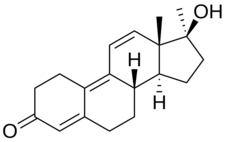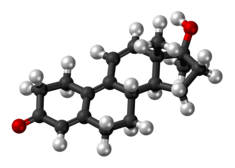Metribolone
Metribolone (developmental code name R1881), also known as methyltrienolone, is a synthetic and orally active anabolic–androgenic steroid (AAS) and a 17α-alkylated nandrolone (19-nortestosterone) derivative which was never marketed for medical use but has been widely used in scientific research as a hot ligand in androgen receptor (AR) ligand binding assays (LBAs) and as a photoaffinity label for the AR.[1][2][3] More precisely, metribolone is the 17α-methylated derivative of the trenbolone. It was investigated briefly for the treatment of advanced breast cancer in women in the late 1960s and early 1970s, but was found to produce signs of severe hepatotoxicity at very low dosages, and its development was subsequently discontinued.[2][4]
 | |
 | |
| Clinical data | |
|---|---|
| Other names | Methyltrienolone, 17α-Methyltrenbolone; R1881; R-1881; RU-1881; NSC-92858; 17α-Methyl-19-nor-Δ9,11-testosterone; 17α-Methylestra-4,9,11-trien-17β-ol-3-one |
| Routes of administration | By mouth |
| Drug class | Androgen; Anabolic steroid; Progestogen |
| Identifiers | |
IUPAC name
| |
| CAS Number | |
| PubChem CID | |
| IUPHAR/BPS | |
| ChemSpider | |
| UNII | |
| KEGG | |
| ChEBI | |
| ChEMBL | |
| CompTox Dashboard (EPA) | |
| ECHA InfoCard | 100.190.113 |
| Chemical and physical data | |
| Formula | C19H24O2 |
| Molar mass | 284.399 g·mol−1 |
| 3D model (JSmol) | |
SMILES
| |
InChI
| |
| (verify) | |
Medical uses
Metribolone was never approved for medical use.[2] As such, it has no approved medical uses.[2] It was studied for the potential treatment of advanced breast cancer in women but development was abandoned.[2][4]
Side effects
Side effects of metribolone include virilization and hepatotoxicity among others.[2]
Pharmacology
Pharmacodynamics
Metribolone is an AAS, or an agonist of the AR, with both anabolic and androgenic activity.[2] It is one of the most potent AAS to have ever been synthesized, with 120 to 300 times the oral anabolic potency and 60 to 70 times the androgenic potency of the reference AAS methyltestosterone in castrated male rats, although the same level of potency has not been observed in studies in humans.[2][4] In addition to the AR, metribolone has high affinity for the progesterone receptor (PR), and binds to the glucocorticoid receptor (GR) as well.[5][6] The drug was also identified in 2007 as a potent antimineralocorticoid, with similar affinity for the mineralocorticoid receptor as aldosterone and spironolactone.[7] In addition, metribolone was identified in 2010 as a potent inhibitor of 3β-hydroxysteroid dehydrogenase (3β-HSD) 1 and 2 (IC50 = 0.02 and 0.16 μM, respectively).[8] On the basis of this finding, it has been said that metribolone should be used very cautiously in scientific research, taking into account 3β-HSD inhibition to avoid erroneous interpretation.[8]
Metribolone has a high potential for hepatotoxicity, similarly to other 17α-alkylated AAS.[9] However, the hepatotoxic potential of metribolone appears to be exceptionally high, likely in relation to its very high potency and metabolic stability; in a study of treatment with the drug for advanced breast cancer, severe hepatic dysfunction was observed at very low dosages.[4]
| Compound | Chemical name | PR | AR | ER | GR | MR |
|---|---|---|---|---|---|---|
| Testosterone | T | 1.0 | 100 | <0.1 | 0.17 | 0.9 |
| Nandrolone | 19-NT | 20 | 154 | <0.1 | 0.5 | 1.6 |
| Trenbolone | ∆9,11-19-NT | 74 | 197 | <0.1 | 2.9 | 1.33 |
| Trestolone | 7α-Me-19-NT | 50–75 | 100–125 | ? | <1 | ? |
| Normethandrone | 17α-Me-19-NT | 100 | 146 | <0.1 | 1.5 | 0.6 |
| Metribolone | ∆9,11-17α-Me-19-NT | 208 | 204 | <0.1 | 26 | 18 |
| Mibolerone | 7α,17α-DiMe-19-NT | 214 | 108 | <0.1 | 1.4 | 2.1 |
| Dimethyltrienolone | ∆9,11-7α,17α-DiMe-19-NT | 306 | 180 | 0.1 | 22 | 52 |
| Notes: Values are percentages (%). Reference ligands (100%) were progesterone for the PR, testosterone for the AR, estradiol for the ER, DEXA for the GR, and aldosterone for the MR. Sources: [10][11] | ||||||
| Compound | rAR (%) | hAR (%) | ||||||
|---|---|---|---|---|---|---|---|---|
| Testosterone | 38 | 38 | ||||||
| 5α-Dihydrotestosterone | 77 | 100 | ||||||
| Nandrolone | 75 | 92 | ||||||
| 5α-Dihydronandrolone | 35 | 50 | ||||||
| Ethylestrenol | ND | 2 | ||||||
| Norethandrolone | ND | 22 | ||||||
| 5α-Dihydronorethandrolone | ND | 14 | ||||||
| Metribolone | 100 | 110 | ||||||
| Sources: See template. | ||||||||
Pharmacokinetics
Metribolone has very low affinity for human serum sex hormone-binding globulin (SHBG), less than 5% of that of testosterone and less than 1% of that of dihydrotestosterone (DHT).[12]
Chemistry
Metribolone, also known as 17α-methyltrenbolone, as well as 17α-methyl-δ9,11-19-nortestosterone or 17α-methylestra-4,9,11-trien-17β-ol-3-one, is a synthetic estrane steroid and a 17α-alkylated derivative of nandrolone (19-nortestosterone).[1][2] It is the C17α methylated derivative of trenbolone (δ9,11-19-nortestosterone) and the C9- and C11-dehydrogenated (δ9,11) analogue of normethandrone (17α-methyl-19-nortestosterone).[1][2] Other close relatives and derivatives of metribolone include mibolerone (7α,17α-dimethyl-19-nortestosterone) and dimethyltrienolone (RU-2420; 7α,17α-dimethyl-δ9,11-19-nortestosterone).[1][2] In addition to AAS, trimethyltrienolone (R2956; 2α,2β,17α-trimethyl-δ9,11-19-nortestosterone), a highly potent antiandrogen, has been derived from metribolone.[13][14]
History
Metribolone was first described in the literature in 1965.[2] It was studied clinically in the late 1960s and early 1970s, most notably in the treatment of advanced breast cancer.[2] The drug was found to be effective and showed weak androgenicity, but also produced severe signs of hepatotoxicity, and was ultimately never marketed.[2][4] By the mid-1970s, metribolone was becoming an accepted standard as a ligand and agonist of the AR in scientific research.[2] It remains in wide use for this purpose today.[2] Aside from scientific research, metribolone has also been encountered as an AAS in non-medical contexts, for instance in doping in sports and bodybuilding.[2]
Society and culture
Generic names
Metribolone is the generic name of metribolone and its INN.[1] It is also known by the name methyltrienolone and its developmental code names R1881, R-1881, RU-1881, and RU1881, and is very commonly referred to by these other names rather than as metribolone in the scientific literature.[1]
Doping in sports
Prior to the 2008 Beijing Olympic Games, 11 members of the Greek national weightlifting team and 4 Greek track and field athletes tested positive for metribolone.[15]
References
- J. Elks (14 November 2014). The Dictionary of Drugs: Chemical Data: Chemical Data, Structures and Bibliographies. Springer. pp. 654–. ISBN 978-1-4757-2085-3.
- William Llewellyn (2011). Anabolics. Molecular Nutrition Llc. pp. 546–. ISBN 978-0-9828280-1-4.
- Brinkmann AO, Kuiper GG, de Boer W, Mulder E, Bolt J, van Steenbrugge GJ, van der Molen HJ (January 1986). "Characterization of androgen receptors after photoaffinity labelling with [3H]methyltrienolone (R1881)". Journal of Steroid Biochemistry. 24 (1): 245–9. doi:10.1016/0022-4731(86)90058-0. PMID 2422446.
- Brueggemeier, Robert W. (2006). "Sex Hormones (Male): Analogs and Antagonists". doi:10.1002/3527600906.mcb.200500066. Cite journal requires
|journal=(help) - Singh SM, Gauthier S, Labrie F (February 2000). "Androgen receptor antagonists (antiandrogens): structure-activity relationships". Current Medicinal Chemistry. 7 (2): 211–47. doi:10.2174/0929867003375371. PMID 10637363.
- Ho-Kim MA, Tremblay RR, Dubé JY (November 1981). "Binding of methyltrienolone to glucocorticoid receptors in rat muscle cytosol". Endocrinology. 109 (5): 1418–23. doi:10.1210/endo-109-5-1418. PMID 6975208.
- Takeda AN, Pinon GM, Bens M, Fagart J, Rafestin-Oblin ME, Vandewalle A (2007). "The synthetic androgen methyltrienolone (r1881) acts as a potent antagonist of the mineralocorticoid receptor". Mol. Pharmacol. 71 (2): 473–82. doi:10.1124/mol.106.031112. PMID 17105867.
- Zheng F (2010). "Methyltrienolone (R1881) is a Potent Inhibitor of 3B-Hydroxysteroid Dehydrogenase (3B-HSD) Activity". Characterization of Enzymes Involved in the Metabolism of Dihydrotestosterone, the Most Potent Natural Androgen (PDF) (thesis). pp. 91–103. Retrieved 19 July 2017.
- Krüskemper HL, Noell G (July 1966). "Liver toxicity of a new anabolic agent: methyltrienolone (17-alpha-methyl-4,9,11-estratriene-17 beta-ol-3-one)". Steroids. 8 (1): 13–24. doi:10.1016/0039-128x(66)90114-0. PMID 5955468.
- Delettré J, Mornon JP, Lepicard G, Ojasoo T, Raynaud JP (January 1980). "Steroid flexibility and receptor specificity". J. Steroid Biochem. 13 (1): 45–59. doi:10.1016/0022-4731(80)90112-0. PMID 7382482.
- Ojasoo T, Delettré J, Mornon JP, Turpin-VanDycke C, Raynaud JP (1987). "Towards the mapping of the progesterone and androgen receptors". J. Steroid Biochem. 27 (1–3): 255–69. doi:10.1016/0022-4731(87)90317-7. PMID 3695484.
- Saartok T, Dahlberg E, Gustafsson JA (1984). "Relative binding affinity of anabolic-androgenic steroids: comparison of the binding to the androgen receptors in skeletal muscle and in prostate, as well as to sex hormone-binding globulin". Endocrinology. 114 (6): 2100–6. doi:10.1210/endo-114-6-2100. PMID 6539197.
- V. H. T. James; J. R. Pasqualini (22 October 2013). Proceedings of the Fourth International Congress on Hormonal Steroids: Mexico City, September 1974. Elsevier Science. p. 618. ISBN 978-1-4831-4566-2.
R-2956 [41-43], a dimethyl derivative of an extremely potent androgen, R 1881 [44], is a powerful testosterone antagonist with very low androgenic activity.
- A. F. Harms (1 January 1986). Innovative Approaches in Drug Research: Proceedings of the Third Noordwijkerhout Symposium on Medicinal Chemistry, Held in the Netherlands, September 3-6, 1985. Elsevier. ISBN 978-0-444-42606-2.
At this stage, RU 2956 exerts a competitive effect about 4 times less marked than metribolone may be because the steric hindrance of the dimethyl group in position C-2 interferes with H-bond formation between the C-3 oxygen and the receptor protein, i.e., with the recognition step, and consequently, with the association rate.
- "Eleven Greek weightlifters test positive; coach suspended". Associated Press / USATODAY.com. 2008-04-04. Retrieved 2009-06-28.
External links
- Metribolone at the US National Library of Medicine Medical Subject Headings (MeSH)
- Methyltrienolone - William Llewellyn's Anabolic.org